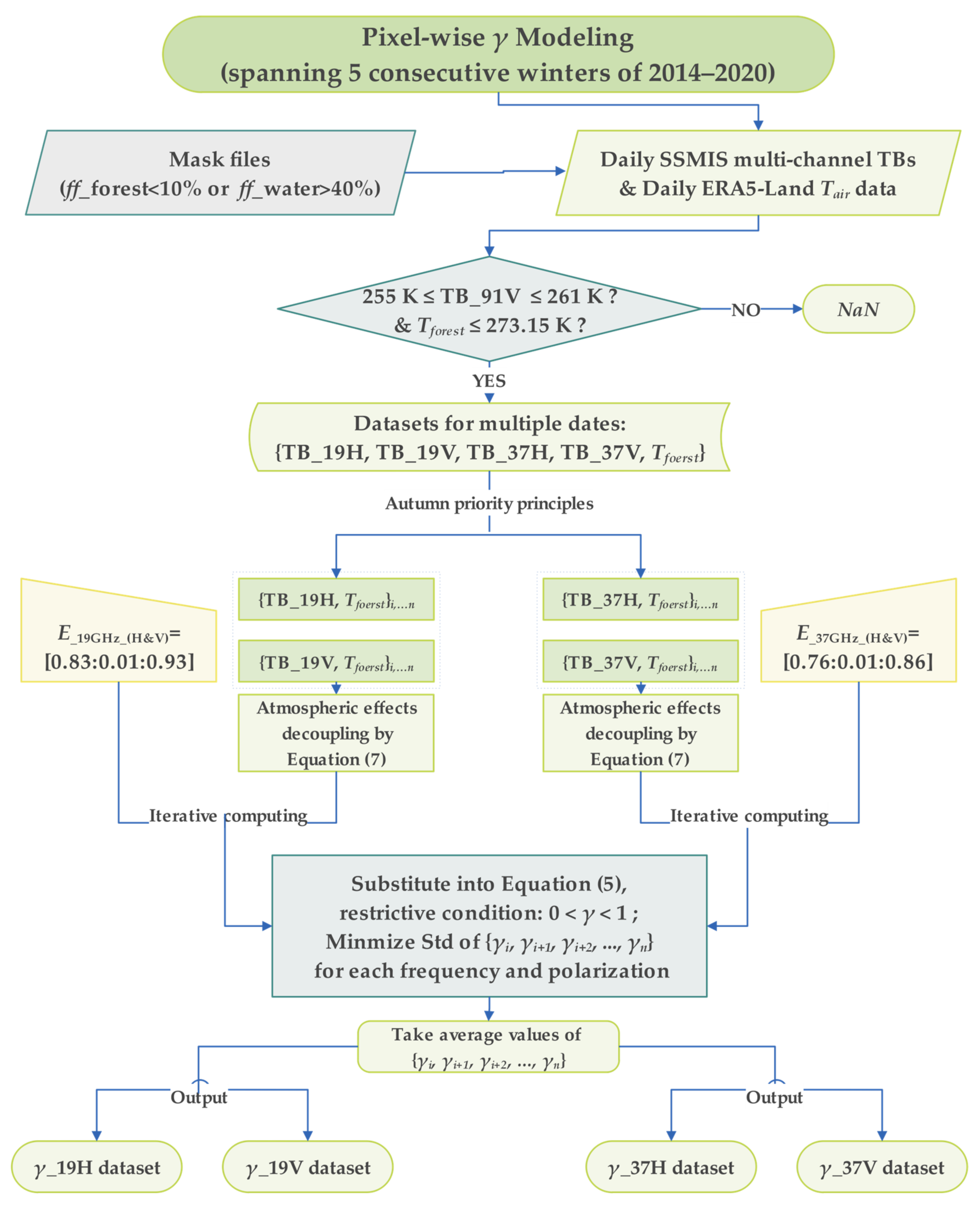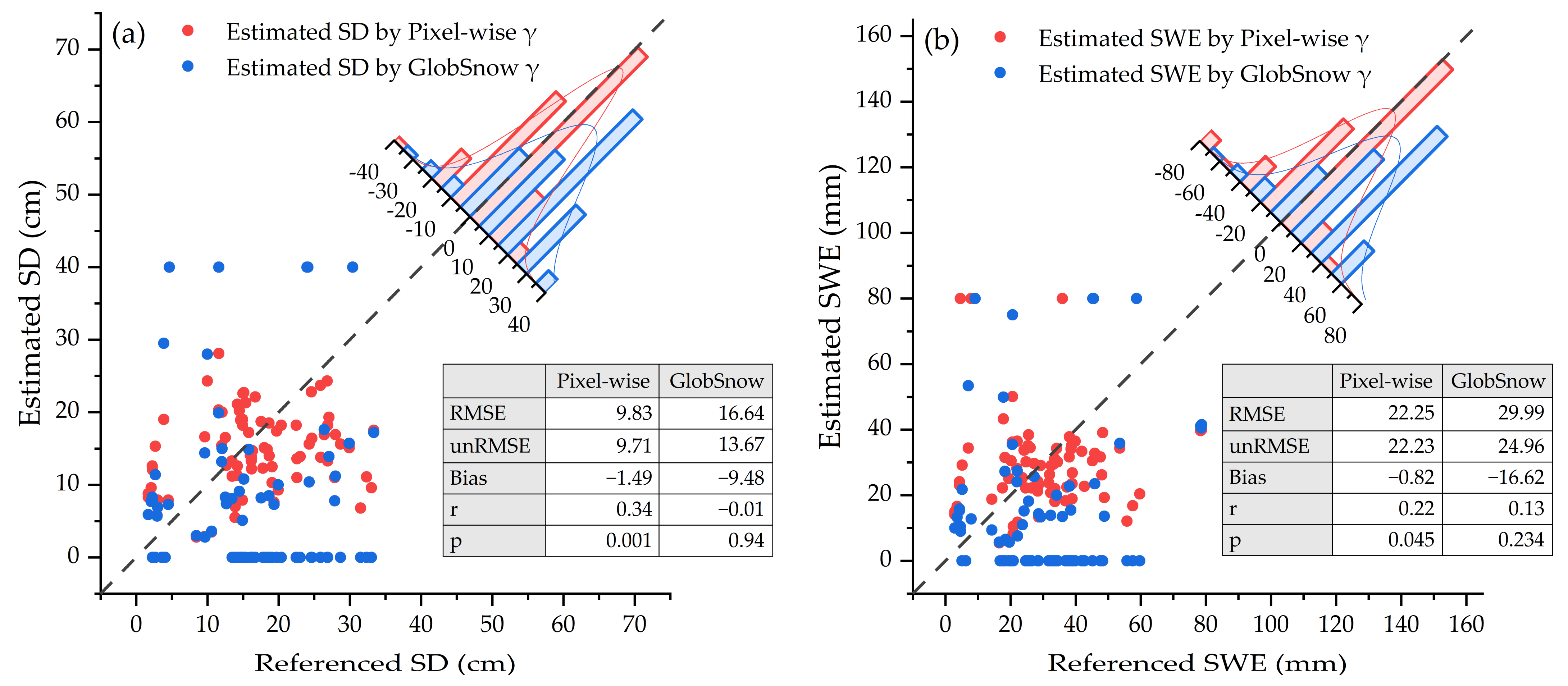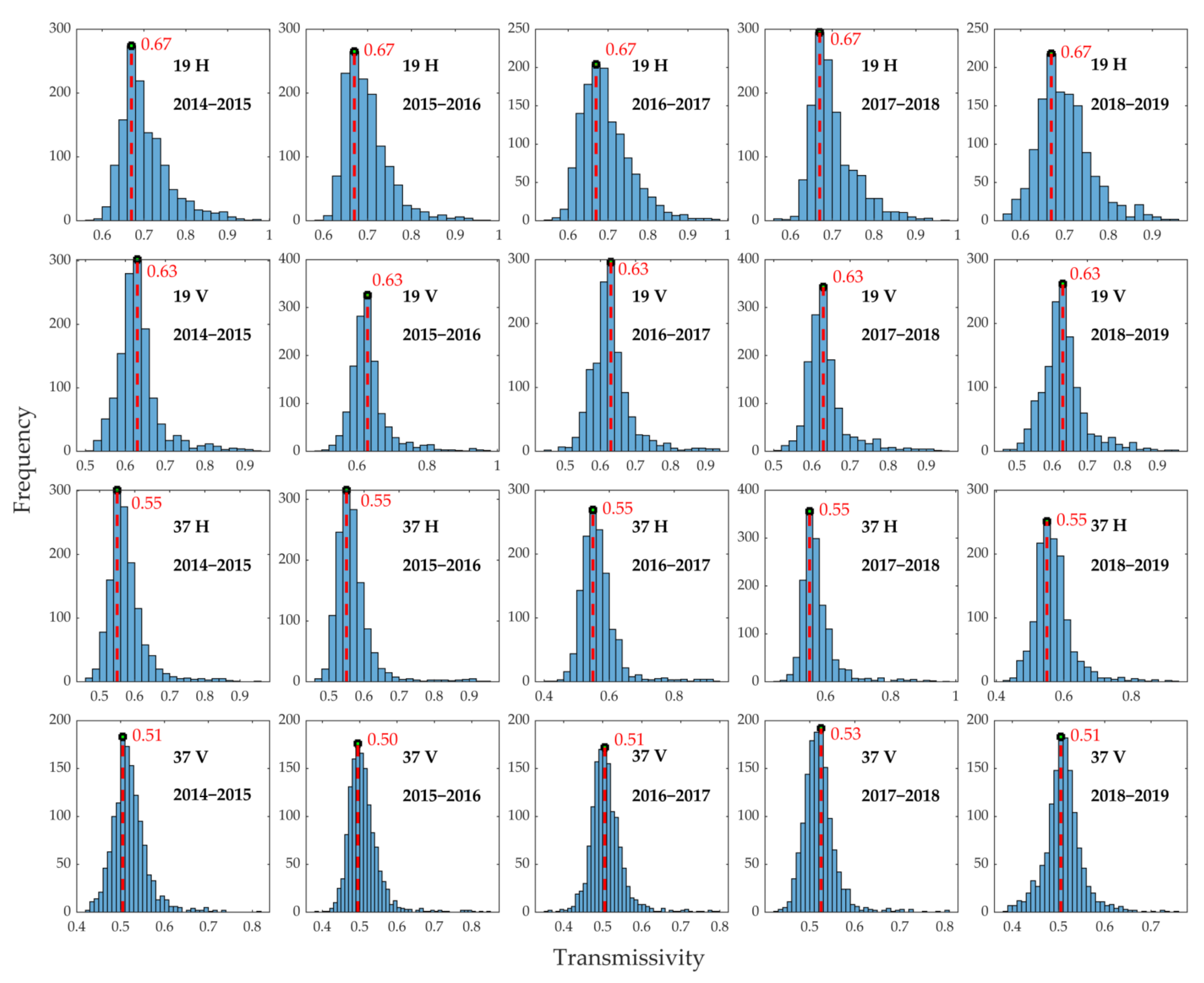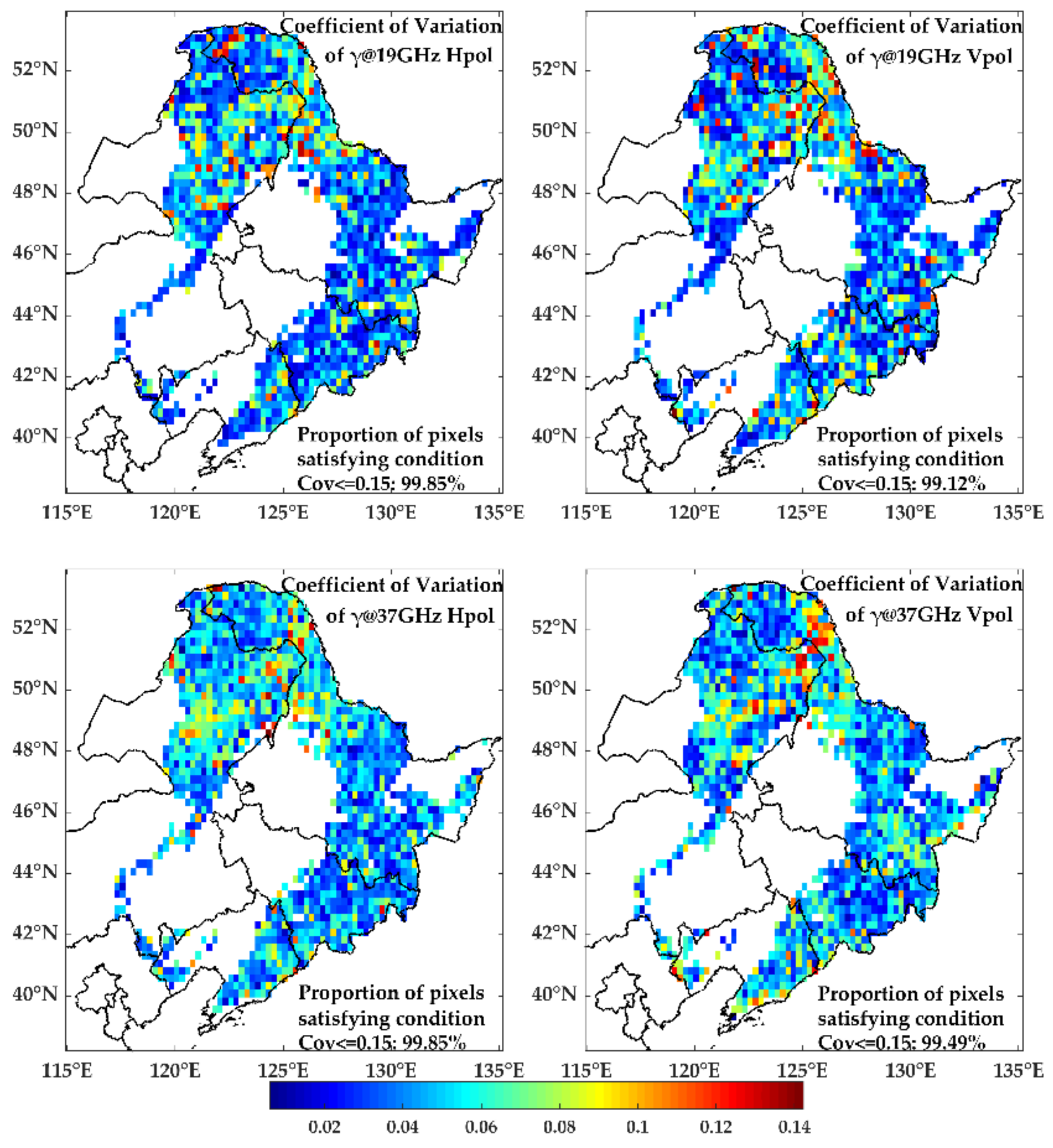Development of a Pixel-Wise Forest Transmissivity Model at Frequencies of 19 GHz and 37 GHz for Snow Depth Inversion in Northeast China
Abstract
:1. Introduction
2. Study Area and Data Set
2.1. Study Area
2.2. Input Data for Forest Microwave Transmissivity Modeling
2.2.1. SSMIS Brightness Temperature
2.2.2. ERA5-Land Daily Air Temperature Data
2.3. Validation Data
2.3.1. Microwave Transmissivity Measurement Data
2.3.2. China’s Snow Survey Data
3. Models and Methodology
3.1. Zeroth Order τ–ω Radiative Transfer Model
3.2. Pixel-Wise Forest Microwave Transmissivity Modeling
- (1)
- Snow characteristics, effective permafrost emissivity and other environmental parameters are considered to be approximately the same for forest and non-forest areas within the same pixel and are set to equal values in the modeling [43];
- (2)
- The value of Pixel-wise γ remains almost constant during each winter season (September to March of the following year). This assumption is reasonable since previous studies [40,43,46] usually assumed that the winter γ at 19 and 37 GHz remains fixed over a more extended time period (generally the period of growth cycles in forest growing stock or aboveground biomass).
3.3. Evaluation Approaches
3.3.1. Direct Validation with Measured Data of Transmissivity
3.3.2. Indirect Validation with Retrieval of SD and SWE
4. Results
4.1. Validation Results
4.1.1. Accuracy Validation Based on Measured Transmissivity
4.1.2. Retrieval of SD and SWE
4.2. Spatio-Temporal Distribution Characteristics of Pixel-Wise Transmissivity
5. Discussion
5.1. Uncertainty Factors Analysis of Pixel-Wise Forest Transmissivity Model
5.2. Influence of Forestcover Fraction
6. Conclusions
Author Contributions
Funding
Data Availability Statement
Acknowledgments
Conflicts of Interest
References
- Kostadinov, T.S.; Schumer, R.; Hausner, M.; Bormann, K.J.; Gaffney, R.; McGwire, K.; Painter, T.H.; Tyler, S.; Harpold, A.A. Watershed-Scale Mapping of Fractional Snow Cover under Conifer Forest Canopy Using Lidar. Remote Sens. Environ. 2019, 222, 34–49. [Google Scholar] [CrossRef]
- Muhuri, A.; Gascoin, S.; Menzel, L.; Kostadinov, T.S.; Harpold, A.A.; Sanmiguel-Vallelado, A.; López-Moreno, J.I. Performance Assessment of Optical Satellite-Based Operational Snow Cover Monitoring Algorithms in Forested Landscapes. IEEE J. Sel. Top. Appl. Earth Obs. Remote Sens. 2021, 14, 7159–7178. [Google Scholar] [CrossRef]
- Kelly, R.E.; Saberi, N.; Li, Q. Development and Evaluation of the GCOM-W1 AMSR2 Snow Depth and Snow Water Equivalent Algorithm. In Proceedings of the AGU Fall Meeting Abstracts; San Francisco, CA, USA, 14–18 December 2015; American Geophysical Union: San Francisco, CA, USA, 2015; Volume 2015, p. C41D-0752. [Google Scholar]
- Pulliainen, J. Mapping of Snow Water Equivalent and Snow Depth in Boreal and Sub-Arctic Zones by Assimilating Space-Borne Microwave Radiometer Data and Ground-Based Observations. Remote Sens. Environ. 2006, 101, 257–269. [Google Scholar] [CrossRef]
- Takala, M.; Luojus, K.; Pulliainen, J.; Derksen, C.; Lemmetyinen, J.; Kärnä, J.-P.; Koskinen, J.; Bojkov, B. Estimating Northern Hemisphere Snow Water Equivalent for Climate Research through Assimilation of Space-Borne Radiometer Data and Ground-Based Measurements. Remote Sens. Environ. 2011, 115, 3517–3529. [Google Scholar] [CrossRef]
- Luojus, K.; Pulliainen, J.; Takala, M.; Lemmetyinen, J.; Mortimer, C.; Derksen, C.; Mudryk, L.; Moisander, M.; Hiltunen, M.; Smolander, T. GlobSnow v3. 0 Northern Hemisphere Snow Water Equivalent Dataset. Sci. Data 2021, 8, 1–16. [Google Scholar] [CrossRef] [PubMed]
- Yang, J.; Jiang, L.; Luojus, K.; Pan, J.; Lemmetyinen, J.; Takala, M.; Wu, S. Snow Depth Estimation and Historical Data Reconstruction over China Based on a Random Forest Machine Learning Approach. Cryosphere 2020, 14, 1763–1778. [Google Scholar] [CrossRef]
- Che, T.; Dai, L.; Zheng, X.; Li, X.; Zhao, K. Estimation of Snow Depth from Passive Microwave Brightness Temperature Data in Forest Regions of Northeast China. Remote Sens. Environ. 2016, 183, 334–349. [Google Scholar] [CrossRef]
- Foster, J.L.; Chang, A.T.C.; Hall, D.K. Comparison of Snow Mass Estimates from a Prototype Passive Microwave Snow Algorithm, a Revised Algorithm and a Snow Depth Climatology. Remote Sens. Environ. 1997, 62, 132–142. [Google Scholar] [CrossRef]
- Chang, A.T.C.; Foster, J.L.; Hall, D.K. Effects of Forest on the Snow Parameters Derived from Microwave Measurements During the Boreas Winter Field Campaign. Hydrol. Process. 1996, 10, 1565–1574. [Google Scholar] [CrossRef]
- Ferrazzoli, P.; Guerriero, L. Passive Microwave Remote Sensing of Forests: A Model Investigation. IEEE Trans. Geosci. Remote Sens. 1996, 34, 433–443. [Google Scholar] [CrossRef]
- Karam, M.A.; Amar, F.; Fung, A.K.; Mougin, E.; Lopes, A.; Le Vine, D.M.; Beaudoin, A. A Microwave Polarimetric Scattering Model for Forest Canopies Based on Vector Radiative Transfer Theory. Remote Sens. Environ. 1995, 53, 16–30. [Google Scholar] [CrossRef]
- Kurum, M.; Lang, R.H.; O’Neill, P.E.; Joseph, A.T.; Jackson, T.J.; Cosh, M.H. A First-Order Radiative Transfer Model for Microwave Radiometry of Forest Canopies at L-Band. IEEE Trans. Geosci. Remote Sens. 2011, 49, 3167–3179. [Google Scholar] [CrossRef]
- Larue, F.; Royer, A.; De Sève, D.; Langlois, A.; Roy, A.; Brucker, L. Validation of GlobSnow-2 Snow Water Equivalent over Eastern Canada. Remote Sens. Environ. 2017, 194, 264–277. [Google Scholar] [CrossRef] [PubMed] [Green Version]
- Mo, T.; Choudhury, B.J.; Schmugge, T.J.; Wang, J.R.; Jackson, T.J. A Model for Microwave Emission from Vegetation-Covered Fields. J. Geophys. Res. Ocean. 1982, 87, 11229–11237. [Google Scholar] [CrossRef]
- Ulaby, F.T.; Moore, R.K.; Fung, A.K. From Theory to Applications. In Microwave Remote Sensing Active and Passive; Artech House Publishers: Norwood, MA, USA, 1986; Volume 3. [Google Scholar]
- Roy, A.; Royer, A.; Wigneron, J.-P.; Langlois, A.; Bergeron, J.; Cliche, P. A Simple Parameterization for a Boreal Forest Radiative Transfer Model at Microwave Frequencies. Remote Sens. Environ. 2012, 124, 371–383. [Google Scholar] [CrossRef]
- El-Rayes, M.A.; Ulaby, F.T. Microwave Dielectric Spectrum of Vegetation-Part I: Experimental Observations. IEEE Trans. Geosci. Remote Sens. 1987, 5, 541–549. [Google Scholar] [CrossRef]
- Mätzler, C. Microwave Transmissivity of a Forest Canopy: Experiments Made with a Beech. Remote Sens. Environ. 1994, 48, 172–180. [Google Scholar] [CrossRef]
- Pardé, M.; Goïta, K.; Royer, A.; Vachon, F. Boreal Forest Transmissivity in the Microwave Domain Using Ground-Based Measurements. IEEE Geosci. Remote Sens. Lett. 2005, 2, 169–171. [Google Scholar] [CrossRef]
- De Roo, R.D.; Chang, A.R.; England, A.W. Radiobrightness at 6.7-, 19-, and 37-GHz Downwelling from Mature Evergreen Trees Observed during the Cold Lands Processes Experiment in Colorado. IEEE Trans. Geosci. Remote Sens. 2007, 45, 3224–3229. [Google Scholar] [CrossRef]
- Santi, E.; Paloscia, S.; Pampaloni, P.; Pettinato, S. Ground-Based Microwave Investigations of Forest Plots in Italy. IEEE Trans. Geosci. Remote Sens. 2009, 47, 3016–3025. [Google Scholar] [CrossRef]
- Li, Q.; Kelly, R.; Lemmetyinen, J.; De Roo, R.D.; Pan, J.; Qiu, Y. The Influence of Tree Transmissivity Variations in Winter on Satellite Snow Parameter Observations. Int. J. Digit. Earth 2021, 14, 1337–1353. [Google Scholar] [CrossRef]
- Guangrui, W.; Xiaofeng, L.; Xiuxue, C.; Tao, J.; Xingming, Z.; Yanlin, W.; Xiangkun, W.; Jian, W. An Investigation on Microwave Transmissivity at Frequencies of 18.7 and 36.5 GHz for Diverse Forest Types during Snow Season. Int. J. Digit. Earth 2021, 14, 1354–1379. [Google Scholar] [CrossRef]
- Ulaby, F.T.; Sarabandi, K.; Mcdonald, K.; Whitt, M.; Dobson, M.C. Michigan Microwave Canopy Scattering Model. Int. J. Remote Sens. 1990, 11, 1223–1253. [Google Scholar] [CrossRef]
- Ferrazzoli, P.; Guerriero, L. Emissivity of Vegetation: Theory and Computational Aspects. J. Electromagn. Waves Appl. 1996, 10, 609–628. [Google Scholar] [CrossRef]
- Ferrazzoli, P.; Guerriero, L.; Rahmoune, R.; Vecchia, A.D. Modeling Forest Emission: Electromagnetic Approximations, Tests, and Application to Retrieval Algorithms. In Proceedings of the 2010 11th Specialist Meeting on Microwave Radiometry and Remote Sensing of the Environment, Washington, DC, USA, 1–4 March 2010; pp. 55–59. [Google Scholar]
- Zhang, X.; Liu, L.; Chen, X.; Gao, Y.; Xie, S.; Mi, J. GLC_FCS30: Global Land-Cover Product with Fine Classification System at 30 m Using Time-Series Landsat Imagery. Earth Syst. Sci. Data 2021, 13, 2753–2776. [Google Scholar] [CrossRef]
- Zhang, L.; Zhang, L.; Du, B.; You, J.; Tao, D. Hyperspectral Image Unsupervised Classification by Robust Manifold Matrix Factorization. Inf. Sci. 2019, 485, 154–169. [Google Scholar] [CrossRef]
- Li, X.; Cheng, G.; Jin, H.; Kang, E.; Che, T.; Jin, R.; Wu, L.; Nan, Z.; Wang, J.; Shen, Y. Cryospheric Change in China. Glob. Planet. Change 2008, 62, 210–218. [Google Scholar] [CrossRef]
- Zou, Y.; Sun, P.; Ma, Z.; Lv, Y.; Zhang, Q. Snow Cover in the Three Stable Snow Cover Areas of China and Spatio-Temporal Patterns of the Future. Remote Sens. 2022, 14, 3098. [Google Scholar] [CrossRef]
- Yan, X.; Zhao, C.; Gou, X. WANG Ying Spatial distributions and variations of the snow cover in the forests of Northeast China. J. Arid. Land Resour. Environ. 2015, 29, 154–162. [Google Scholar]
- Armstrong, R.; Knowles, K.; Brodzik, M.J.; Hardman, M.A. DMSP SSM/I-SSMIS Pathfinder Daily Ease-Grid Brightness Temperatures; Version 2; NASA National Snow and Ice Data Center Distributed Active Archive Center: Boulder, CO, USA, 1994. [Google Scholar]
- Yang, J.W.; Jiang, L.M.; Lemmetyinen, J.; Pan, J.M.; Luojus, K.; Takala, M. Improving Snow Depth Estimation by Coupling HUT-Optimized Effective Snow Grain Size Parameters with the Random Forest Approach. Remote Sens. Environ. 2021, 264, 112630. [Google Scholar] [CrossRef]
- Wang, J.; Che, T.; Li, Z.; Li, H.; Hao, X.; Zheng, Z.; Xiao, P.; Li, X.; Huang, X.; Zhong, X. Investigation on Snow Characteristics and Their Distribution in China. Adv. Earth Sci. 2018, 33, 12–26. [Google Scholar]
- Dai, L.; Che, T.; Xie, H.; Wu, X. Estimation of Snow Depth over the Qinghai-Tibetan Plateau Based on AMSR-E and MODIS Data. Remote Sens. 2018, 10, 1989. [Google Scholar] [CrossRef]
- Shahroudi, N.; Rossow, W. Using Land Surface Microwave Emissivities to Isolate the Signature of Snow on Different Surface Types. Remote Sens. Environ. 2014, 152, 638–653. [Google Scholar] [CrossRef]
- Xiao, X.; He, T.; Liang, S.; Zhao, T. Improving Fractional Snow Cover Retrieval from Passive Microwave Data Using a Radiative Transfer Model and Machine Learning Method. IEEE Trans. Geosci. Remote Sens. 2022, 60, 1–15. [Google Scholar] [CrossRef]
- Rahmoune, R.; Ferrazzoli, P.; Kerr, Y.H.; Richaume, P. SMOS Level 2 Retrieval Algorithm over Forests: Description and Generation of Global Maps. IEEE J. Sel. Top. Appl. Earth Obs. Remote Sens. 2013, 6, 1430–1439. [Google Scholar] [CrossRef]
- Langlois, A.; Royer, A.; Dupont, F.; Roy, A.; Goita, K.; Picard, G. Improved Corrections of Forest Effects on Passive Microwave Satellite Remote Sensing of Snow over Boreal and Subarctic Regions. IEEE Trans. Geosci. Remote Sens. 2011, 49, 3824–3837. [Google Scholar] [CrossRef]
- Pampaloni, P.; Paloscia, S. Microwave Emission and Plant Water Content: A Comparison between Field Measurements and Theory. IEEE Trans. Geosci. Remote Sens. 1986, 24, 900–905. [Google Scholar] [CrossRef]
- Kurvonen, L.; Hallikainen, M. Influence of Land-Cover Category on Brightness Temperature of Snow. IEEE Trans. Geosci. Remote Sens. 1997, 35, 367–377. [Google Scholar] [CrossRef]
- Kruopis, N.; Praks, J.; Nadir Arslan, A.; Alasalmi, H.M.; Koskinen, J.T.; Hallikainen, M.T. Passive Microwave Measurements of Snow-Covered Forest Areas in EMAC’95. IEEE Trans. Geosci. Remote Sens. 1999, 37, 2699–2705. [Google Scholar] [CrossRef]
- Jones, L.A.; Kimball, J.S.; McDonald, K.C.; Chan, S.T.K.; Njoku, E.G.; Oechel, W.C. Satellite Microwave Remote Sensing of Boreal and Arctic Soil Temperatures from AMSR-E. IEEE Trans. Geosci. Remote Sens. 2007, 45, 2004–2018. [Google Scholar] [CrossRef]
- Grant, J.P.; Saleh-Contell, K.; Wigneron, J.-P.; Guglielmetti, M.; Kerr, Y.H.; Schwank, M.; Skou, N.; Van de Griend, A.A. Calibration of the L-MEB Model over a Coniferous and a Deciduous Forest. IEEE Trans. Geosci. Remote Sens. 2008, 46, 808–818. [Google Scholar] [CrossRef]
- Cohen, J.; Lemmetyinen, J.; Pulliainen, J.; Heinila, K.; Montomoli, F.; Seppanen, J.; Hallikainen, M.T. The Effect of Boreal Forest Canopy in Satellite Snow Mapping—A Multisensor Analysis. IEEE Trans. Geosci. Remote Sens. 2015, 53, 6593–6607. [Google Scholar] [CrossRef]
- Kelly, R. The AMSR-E Snow Depth Algorithm: Description and Initial Results. J. Remote Sens. Soc. Jpn. 2009, 29, 307–317. [Google Scholar]
- Choudhury, B.J.; Kerr, Y.H.; Njoku, E.G.; Pampaloni, P. Passive Microwave Remote Sensing of Land-Atmosphere Interactions. In Proceedings of the ESA/NASA International Workshop, Saint Lary, France, 11–15 January 1993; Walter de Gruyter GmbH & Co KG: Berlin, Germany, 2020. [Google Scholar]
- Xue, Y.; Forman, B.A. Atmospheric and Forest Decoupling of Passive Microwave Brightness Temperature Observations Over Snow-Covered Terrain in North America. IEEE J. Sel. Top. Appl. Earth Obs. Remote Sens. 2017, 10, 3172–3189. [Google Scholar] [CrossRef]
- Aschbacher, J. Land Surface Studies and Atmospheric Effects by Satellite Microwave Radiometry. Ph.D. Dissertation, Institute for Meteorology and Geophysics, University of Innsbruck, Innsbruck, Austria, 1989. [Google Scholar]
- Pulliainen, J.; Karna, J.-P.; Hallikainen, M. Development of Geophysical Retrieval Algorithms for the MIMR. IEEE Trans. Geosci. Remote Sens. 1993, 31, 268–277. [Google Scholar] [CrossRef]
- Wu, L.; Li, X.; Zhao, K.; Zheng, X. Snow Depth Inversion Using the Localized HUT Model Based on FY-3B MWRI Data in the Farmland of Heilongjiang Province, China. J. Indian Soc. Remote Sens. 2017, 45, 89–100. [Google Scholar] [CrossRef]
- Mätzler, C. Passive Microwave Signatures of Landscapes in Winter. Meteorol. Atmos. Phys. 1994, 54, 241–260. [Google Scholar] [CrossRef]
- Wiesmann, A.; Mätzler, C. Microwave Emission Model of Layered Snowpacks. Remote Sens. Environ. 1999, 70, 307–316. [Google Scholar] [CrossRef]
- Weng, F.; Yan, B.; Grody, N.C. A Microwave Land Emissivity Model. J. Geophys. Res. Atmos. 2001, 106, 20115–20123. [Google Scholar] [CrossRef]
- Yan, B.; Weng, F. Ten-Year (1993–2002) Time-Series of Microwave Land Emissivity. In Proceedings of the Microwave Remote Sensing of the Atmosphere and Environment III; SPIE-Int Soc Optical Engineering: Hangzhou, China, 2003; Volume 4894, pp. 278–286. [Google Scholar] [CrossRef]
- Lemmetyinen, J.; Derksen, C.; Toose, P.; Proksch, M.; Pulliainen, J.; Kontu, A.; Rautiainen, K.; Seppänen, J.; Hallikainen, M. Simulating Seasonally and Spatially Varying Snow Cover Brightness Temperature Using HUT Snow Emission Model and Retrieval of a Microwave Effective Grain Size. Remote Sens. Environ. 2015, 156, 71–95. [Google Scholar] [CrossRef]
- Pulliainen, J.T.; Grandell, J.; Hallikainen, M.T. HUT Snow Emission Model and Its Applicability to Snow Water Equivalent Retrieval. IEEE Trans. Geosci. Remote Sens. 1999, 37, 1378–1390. [Google Scholar] [CrossRef]
- Liebe, H.J. MPM?An Atmospheric Millimeter-Wave Propagation Model. Int J. Infrared Milli Waves 1989, 10, 631–650. [Google Scholar] [CrossRef]
- Salonen, E.; Karhu, S.; Jokela, P.; Zhang, W.; Uppala, S.; Aulamo, H.; Sarkkula, S. Study of Propagation Phenomena for Low Availabilities; Final Report for the European Space Agency under ESTEC Contract 8025/88/NL/PR; Helsinki University of Technology Radio Laboratory and Finnish Meteorological Institute: Helsinki, Finland, 1990; pp. 193–244. [Google Scholar]
- Wang, J.R.; Choudhury, B.J. Remote Sensing of Soil Moisture Content, over Bare Field at 1.4 GHz Frequency. J. Geophys. Res. Ocean. 1981, 86, 5277–5282. [Google Scholar] [CrossRef]
- Hollinger, J.P.; Peirce, J.L.; Poe, G.A. SSM/I Instrument Evaluation. IEEE Trans. Geosci. Remote Sens. 1990, 28, 781–790. [Google Scholar] [CrossRef]
- Santoro, M. GlobBiomass-Global Datasets of Forest Biomass. PANGAEA. Geophys. Res. Abstr. 2018, 20, EGU2018–18932. [Google Scholar] [CrossRef]
- De Jong, R.; de Bruin, S.; de Wit, A.; Schaepman, M.E.; Dent, D.L. Analysis of Monotonic Greening and Browning Trends from Global NDVI Time-Series. Remote Sens. Environ. 2011, 115, 692–702. [Google Scholar] [CrossRef] [Green Version]
- Alcaraz-Segura, D.; Liras, E.; Tabik, S.; Paruelo, J.; Cabello, J. Evaluating the Consistency of the 1982–1999 NDVI Trends in the Iberian Peninsula across Four Time-Series Derived from the AVHRR Sensor: LTDR, GIMMS, FASIR, and PAL-II. Sensors 2010, 10, 1291–1314. [Google Scholar] [CrossRef] [PubMed]
- Daufresne, M.; Lengfellner, K.; Sommer, U. Global Warming Benefits the Small in Aquatic Ecosystems. Proc. Natl. Acad. Sci. USA 2009, 106, 12788–12793. [Google Scholar] [CrossRef] [Green Version]
- Pearson, K. VII. Mathematical Contributions to the Theory of Evolution.III. Regression, Heredity, and Panmixia. Philos. Trans. R. Soc. London. Ser. A 1896, 187, 253–318. [Google Scholar]
- Bradburn, S. How to Calculate the Coefficient Of Variation (CV). Top Tip Bio 2017. Available online: https://toptipbio.com/calculate-coefficient-variation-cv/ (accessed on 12 December 2021).
- Grody, N.C.; Basist, A.N. Global Identification of Snowcover Using SSM/I Measurements. IEEE Trans. Geosci. Remote Sens. 1996, 34, 237–249. [Google Scholar] [CrossRef]
- Li, Q.; Kelly, R.; Leppänen, L.; Vehviläinen, J.; Kontu, A.; Lemmetyinen, J.; Pulliainen, J. The Influence of Thermal Properties and Canopy-Intercepted Snow on Passive Microwave Transmissivity of a Scots Pine. IEEE Trans. Geosci. Remote Sens. 2019, 57, 5424–5433. [Google Scholar] [CrossRef]
- Kou, X.; Chai, L.; Jiang, L.; Zhao, S.; Yan, S. Modeling of the Permittivity of Holly Leaves in Frozen Environments. IEEE Trans. Geosci. Remote Sens. 2015, 53, 6048–6057. [Google Scholar] [CrossRef]
- Xiao, X.; Zhang, T.; Zhong, X.; Shao, W.; Li, X. Support Vector Regression Snow-Depth Retrieval Algorithm Using Passive Microwave Remote Sensing Data. Remote Sens. Environ. 2018, 210, 48–64. [Google Scholar] [CrossRef]
- Sturm, M.; Holmgren, J.; Liston, G.E. A Seasonal Snow Cover Classification System for Local to Global Applications. J. Clim. 1995, 8, 1261–1283. [Google Scholar] [CrossRef]







| Model | Purpose | Key Parameters | Unit | Data Source or Value Taking |
|---|---|---|---|---|
| Atmospheric Statistical Model [46,47,50,51] | To calculate the atmospheric upwelling and downwelling emission and transmissivity | Air temperature | K | ERA5-Land |
| Statistical coefficient | Unitless | Recalibration based on atmospheric physical model (MPM, [54]) and sounding data | ||
| Zeroth-order τ–ω Radiative Transfer Model [15] | To simulate the interaction between canopy and electromagnetic wave | Forest transmissivity | Unitless | Newly developed Pixel-wise forest transmissivity model in this study |
| Single scattering albedo | Unitless | 0 | ||
| Forest canopy temperature | K | ERA5-Land, assuming the forest canopy temperature and air temperature are the same | ||
| HUT Snow Emission Model [58] | To simulate snow emission of 19 GHz and 37 GHz | Snow temperature | K | China’s snow survey data |
| Snow volumetric humidity | % | China’s snow survey data | ||
| Snow density | kg/m3 | China’s snow survey data | ||
| SWE | cm | China’s snow survey data | ||
| Snow grain size | mm | China’s snow survey data | ||
| Rough Bare Soil Reflectance Model [61] | To simulate the ground surface microwave emissivity | Soil surface roughness | mm | 3 |
| Relative permittivity of permafrost | Unitless | |||
| Q | Unitless | 0.01-parameter calibrated | ||
| H | Unitless | 0.09-parameter calibrated | ||
| NP | Unitless | 0.92-parameter calibrated | ||
| NV | Unitless | 0.92-parameter calibrated |
| Point | Row_Id | Col_ Id | γ19H_Obs | γ19V_ Obs | γ37H_Obs | γ37V _Obs | γ19H_ Est | γ19V_ Est | γ37H_ Est | γ37V_ Est |
|---|---|---|---|---|---|---|---|---|---|---|
| Mohe01 | 5 | 31 | 0.63 | 0.57 | 0.60 | 0.58 | 0.62 | 0.61 | 0.60 | 0.59 |
| Huma01 | 10 | 37 | 0.68 | 0.61 | 0.58 | 0.59 | 0.65 | 0.61 | 0.54 | 0.57 |
| Huma02 | 0.68 | 0.61 | 0.58 | 0.59 | 0.65 | 0.61 | 0.54 | 0.57 | ||
| Huma03 | 10 | 38 | 0.69 | 0.70 | 0.59 | 0.60 | 0.65 | 0.60 | 0.54 | 0.52 |
| Huma04 | 0.69 | 0.70 | 0.59 | 0.60 | 0.65 | 0.60 | 0.54 | 0.52 | ||
| Huma05 | 0.69 | 0.70 | 0.59 | 0.60 | 0.65 | 0.60 | 0.54 | 0.52 | ||
| Xunke01 | 21 | 55 | 0.66 | 0.60 | 0.57 | 0.60 | 0.71 | 0.62 | 0.64 | 0.55 |
| Xunke02 | 0.66 | 0.60 | 0.57 | 0.60 | 0.71 | 0.62 | 0.64 | 0.55 | ||
| Xunke03 | 0.66 | 0.60 | 0.57 | 0.60 | 0.71 | 0.62 | 0.64 | 0.55 | ||
| Xunke04 | 21 | 56 | 0.58 | 0.50 | 0.53 | 0.55 | 0.69 | 0.64 | 0.59 | 0.56 |
| Yichun01 | 25 | 56 | 0.54 | 0.28 | 0.47 | 0.49 | 0.63 | 0.66 | 0.51 | 0.47 |
| Yichun02 | 0.54 | 0.28 | 0.47 | 0.49 | 0.63 | 0.66 | 0.51 | 0.47 | ||
| Yichun03 | 24 | 57 | 0.36 | 0.20 | 0.32 | 0.34 | 0.65 | 0.62 | 0.53 | 0.49 |
| Yichun04 | 24 | 58 | 0.34 | 0.64 | 0.54 | 0.56 | 0.65 | 0.66 | 0.53 | 0.50 |
| 2014–2015 | 2015–2016 | 2016–2017 | 2017–2018 | 2018–2019 | ||
|---|---|---|---|---|---|---|
| 19 GHz (H) | min | 0.58 | 0.60 | 0.56 | 0.56 | 0.56 |
| max | 0.97 | 0.97 | 0.97 | 0.97 | 0.96 | |
| Bin_left * | 0.66 | 0.66 | 0.66 | 0.66 | 0.66 | |
| Bin_right * | 0.68 | 0.68 | 0.68 | 0.68 | 0.68 | |
| 19 GHz (V) | min | 0.44 | 0.48 | 0.43 | 0.46 | 0.46 |
| max | 0.97 | 0.97 | 0.94 | 0.96 | 0.95 | |
| Bin_left * | 0.62 | 0.62 | 0.62 | 0.62 | 0.62 | |
| Bin_right * | 0.64 | 0.64 | 0.64 | 0.64 | 0.64 | |
| 37 GHz (H) | min | 0.47 | 0.46 | 0.41 | 0.45 | 0.43 |
| max | 0.95 | 0.95 | 0.94 | 0.97 | 0.92 | |
| Bin_left * | 0.54 | 0.54 | 0.54 | 0.54 | 0.54 | |
| Bin_right * | 0.56 | 0.56 | 0.56 | 0.56 | 0.56 | |
| 37 GHz (V) | min | 0.39 | 0.38 | 0.34 | 0.41 | 0.39 |
| max | 0.88 | 0.86 | 0.81 | 0.84 | 0.76 | |
| Bin_left * | 0.50 | 0.49 | 0.50 | 0.52 | 0.51 | |
| Bin_right * | 0.51 | 0.50 | 0.51 | 0.53 | 0.52 |
| Interval | Sample Size | RMSE (cm) | |
|---|---|---|---|
| Pixel-Wise Model | GlobSnow Model | ||
| (0.1, 0.2] | 10 | 9.1 | 12.0 |
| (0.2, 0.3] | 7 | 9.3 | 8.9 |
| (0.3, 0.4] | 6 | 10.4 | 9.8 |
| (0.4, 0.5] | 3 | 23.0 | 25.8 |
| (0.5, 0.6] | 1 | 15.9 | 16.2 |
| (0.6, 0.7] | 0 | - | - |
| (0.7, 0.8] | 6 | 10.3 | 13.8 |
| (0.8, 0.9] | 3 | 9.4 | 8.2 |
| (0.9, 1] | 51 | 8.4 | 18.7 |
Publisher’s Note: MDPI stays neutral with regard to jurisdictional claims in published maps and institutional affiliations. |
© 2022 by the authors. Licensee MDPI, Basel, Switzerland. This article is an open access article distributed under the terms and conditions of the Creative Commons Attribution (CC BY) license (https://creativecommons.org/licenses/by/4.0/).
Share and Cite
Wang, G.-R.; Li, X.-F.; Wang, J.; Wei, Y.-L.; Zheng, X.-M.; Jiang, T.; Chen, X.-X.; Wan, X.-K.; Wang, Y. Development of a Pixel-Wise Forest Transmissivity Model at Frequencies of 19 GHz and 37 GHz for Snow Depth Inversion in Northeast China. Remote Sens. 2022, 14, 5483. https://doi.org/10.3390/rs14215483
Wang G-R, Li X-F, Wang J, Wei Y-L, Zheng X-M, Jiang T, Chen X-X, Wan X-K, Wang Y. Development of a Pixel-Wise Forest Transmissivity Model at Frequencies of 19 GHz and 37 GHz for Snow Depth Inversion in Northeast China. Remote Sensing. 2022; 14(21):5483. https://doi.org/10.3390/rs14215483
Chicago/Turabian StyleWang, Guang-Rui, Xiao-Feng Li, Jian Wang, Yan-Lin Wei, Xing-Ming Zheng, Tao Jiang, Xiu-Xue Chen, Xiang-Kun Wan, and Yan Wang. 2022. "Development of a Pixel-Wise Forest Transmissivity Model at Frequencies of 19 GHz and 37 GHz for Snow Depth Inversion in Northeast China" Remote Sensing 14, no. 21: 5483. https://doi.org/10.3390/rs14215483






